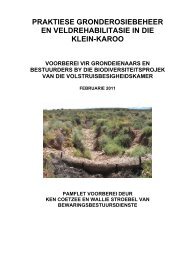REHABILITATION: REHABILITATION: A QUICK GUIDE A ... - saobc
REHABILITATION: REHABILITATION: A QUICK GUIDE A ... - saobc
REHABILITATION: REHABILITATION: A QUICK GUIDE A ... - saobc
Create successful ePaper yourself
Turn your PDF publications into a flip-book with our unique Google optimized e-Paper software.
only be collected along roads, where they are displaced during road-making, or<br />
from piles of stones cleared off irrigation lands. Similarly, natural vegetation should<br />
not be destroyed by vehicles collecting or delivering materials for gulley control.<br />
Where stones are in short supply, consideration should rather be given to the use of<br />
alternative construction materials that will result in lower environmental impact.<br />
Figures 6C, 6D, 6E & 6F illustrate some of the frequently used methods for gulley<br />
erosion control that are suitable for use on Highlands. Figure 6G illustrates the<br />
most effective approach for the control of a network of gulleys. This sequence<br />
should guide all erosion control actions.<br />
Gulley checks, or gabion structures, often fail if the treatment does not include the<br />
establishment of a vegetation cover. Seeding, or planting, should thus immediately<br />
follow the check dam construction for the most effective results.<br />
The type of gabion, or barrier, that is used should be determined by the availability<br />
of material close to the erosion system to be treated. It makes little sense to<br />
transport stones over great distances, at great expense, when alternative materials<br />
are available closer to the work site. A certain degree of imaginative innovation is<br />
thus required when determining which type of barrier to construct.<br />
The indiscriminate removal of stones from natural rangeland is not a good idea<br />
because each stone may shelter a microhabitat, shades the soil, reduces<br />
excessively high soil temperatures and preserves soil moisture. Removing stones<br />
will thus destabilize the site they are removed from, thereby risking a new source of<br />
erosion.<br />
Consider stones as animal habitat. Turn a number of stones over in any natural<br />
rangeland and you will probably find an amazing variety of invertebrates including<br />
ants, termites, beetles, woodlice, centipedes, slugs, spiders and scorpions. These<br />
creatures, together with the more microscopic soil organisms on which they are<br />
dependent, are the architects, miners and builders of soil. To build and enrich the<br />
soil, they need moisture, protection from the sun and protection against the host of<br />
larger predators that feed on them.<br />
Loading and removing all the handy-sized loose stones from an area of rangeland<br />
for the construction of an erosion control gabion may therefore disrupt a great<br />
number of micro habitats, food chains and possibly the productive potential of the<br />
soil at the site.<br />
Surface stones in stable rangeland also play an important part in soil erosion<br />
prevention. They divert and reduce the speed and force of runoff water and they<br />
trap water-carried soil particles and organic matter. They help to trap valuable plant<br />
litter and keep it in place over the soil, protecting and enriching the soil and the<br />
important detritivores that live in it.<br />
Stones thus have an important function in rangeland ecology and soil protection<br />
and their removal, for whatever purpose, must therefore be very carefully<br />
considered.<br />
22



